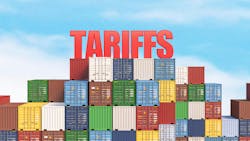How Is Tariff Uncertainty Affecting Interior Designers?
The fluid and ever-evolving nature of U.S. tariffs on its trading partners has interior designers wondering what’s next.
On April 10, President Donald J. Trump suspended for 90 days import taxes on dozens of countries—taxes which he had announced less than a day earlier. Previously, the president had said he planned to impose tariffs on nearly every country; this announcement was delivered on April 2, which the president referred to as “Liberation Day.” Then, on April 9, President Trump announced “reciprocal” tariffs on countries that he said were engaging in unfair trading practices. The April 9 tariffs are the ones that were suspended for 90 days.
It remains to be seen what will happen after the 90-day period expires, but manufacturers and the designers who rely on them are trying to determine what will happen in a variety of possible scenarios. The American Society of Interior Designers (ASID), a nonpartisan membership organization, is monitoring the situation. Designers can expect the 2025 edition of ASID’s annual economic outlook report to arrive this summer.
Products that are made in the United States may also include raw materials from other countries [...] so even domestically sourced furnishings and other goods may not be safe from tariff-related cost increases.
Which Goods Are Affected by Tariffs?
The previously announced tariffs affected both raw and finished goods, noted Dr. Dawn Haynie, research fellow at ASID, in an interview conducted shortly before the 90-day suspension was announced. An interior design project could include tariffed goods from a number of countries, including lumber from Canada, lighting from China, or textiles from Indonesia or Turkey—all of which were subject to tariffs and are now causing confusion for manufacturers who are trying to stay compliant with rapidly changing regulations, as well as those manufacturers’ clients.
Products that are made in the United States may also include raw materials from other countries—for example, a domestically produced sofa may include a timber frame sourced from Canada—so even domestically sourced furnishings and other goods may not be safe from tariff-related cost increases. ASID’s economist, Dr. Bernie Markstein, predicts that the costs of interior design-related products will increase.
“We saw disruptions in the supply chains specific to raw goods during the pandemic, and there were tariffs that were put on goods by both the first Trump administration and [President Joe] Biden’s administration,” Haynie noted. “You saw a lot of manufacturers trying to pivot to other countries to create some resilience so they didn’t have all their eggs in one basket and there was more distribution and resilience in their manufacturing process. With the current tariffs, people have moved their manufacturing and those countries have had tariffs put on them as well.” Costs of design products and materials have risen sharply from their pre-pandemic state, increasing by almost 40% on average depending on the product category, Haynie noted.
“Our economist is predicting that they’re going to increase again, because the larger companies have the capacity to absorb some of this, but smaller companies have less flexibility,” Haynie noted.
Costs of design products and materials have risen sharply from their pre-pandemic state, increasing by almost 40% on average depending on the product category.
Economic Watch: What to Keep an Eye On
ASID is projecting growth across many market sectors in 2025 and into 2026, but some of the growth is coming from the increased cost of materials, Haynie explained. Some clients can absorb the increased costs, but others will be forced to scale back because their budgets won’t accommodate higher product costs. Designers will need to be nimble in the coming months and consider product substitutions.
“This is affecting price points. It may affect lead times. We anticipate people looking at specifications and changing their choices, which will impact their design and may impact quality as well,” Haynie said. “You might put in something that isn’t as durable and doesn’t have the same longevity, or it may be a synthetic material and not a natural material. There’s a range of competing priorities that designers are going to negotiate to get to a balanced budget.”
ASID’s 2025 economic outlook will be released in mid-2025, but in the meantime, check out 2024’s report—which is free for ASID members—for industry-specific predictions for this year.
About the Author
Janelle Penny
Editor-in-Chief, BUILDINGS
Janelle Penny is a senior writer for i+s and is Editor-in-Chief of BUILDINGS. She has more than a decade of experience in journalism, with a special emphasis on covering facilities. She aims to deliver practical, actionable content for her readers.

